Despite boasting some of the best squad depth in world football, to the extent that any nation would be envious, France have not yet managed to add a third piece of European Championship silverware to their international trophy cabinet.
Didier Deschamps has overseen two Euro campaigns as France manager thus far.
His first European Championship saw his side come agonisingly close to reclaiming the trophy that’s alluded them since 2000, finishing as runners-up to winners Portugal in 2016.
EURO 2020 was one to forget for Les Bleus, with the French crashing out unexpectedly in the Round of 16 versus Switzerland.
This year, they’ll aim to put on a far better showing.
Anything less than an appearance in the final is likely to raise question marks over the squad and, inevitably, their coach.
The goal for France will be to win the European Championship and officially perch themselves back atop the footballing landscape of this continent bursting with talent and competitive sides — where they’ll ultimately feel they belong.
Our tactical analysis and team-focused scout report aims to provide some in-depth analysis of France’s tactics and what viewers can expect from them in this summer’s Euro campaign; without further ado, let’s get into the analysis!
Predicted Starting XI
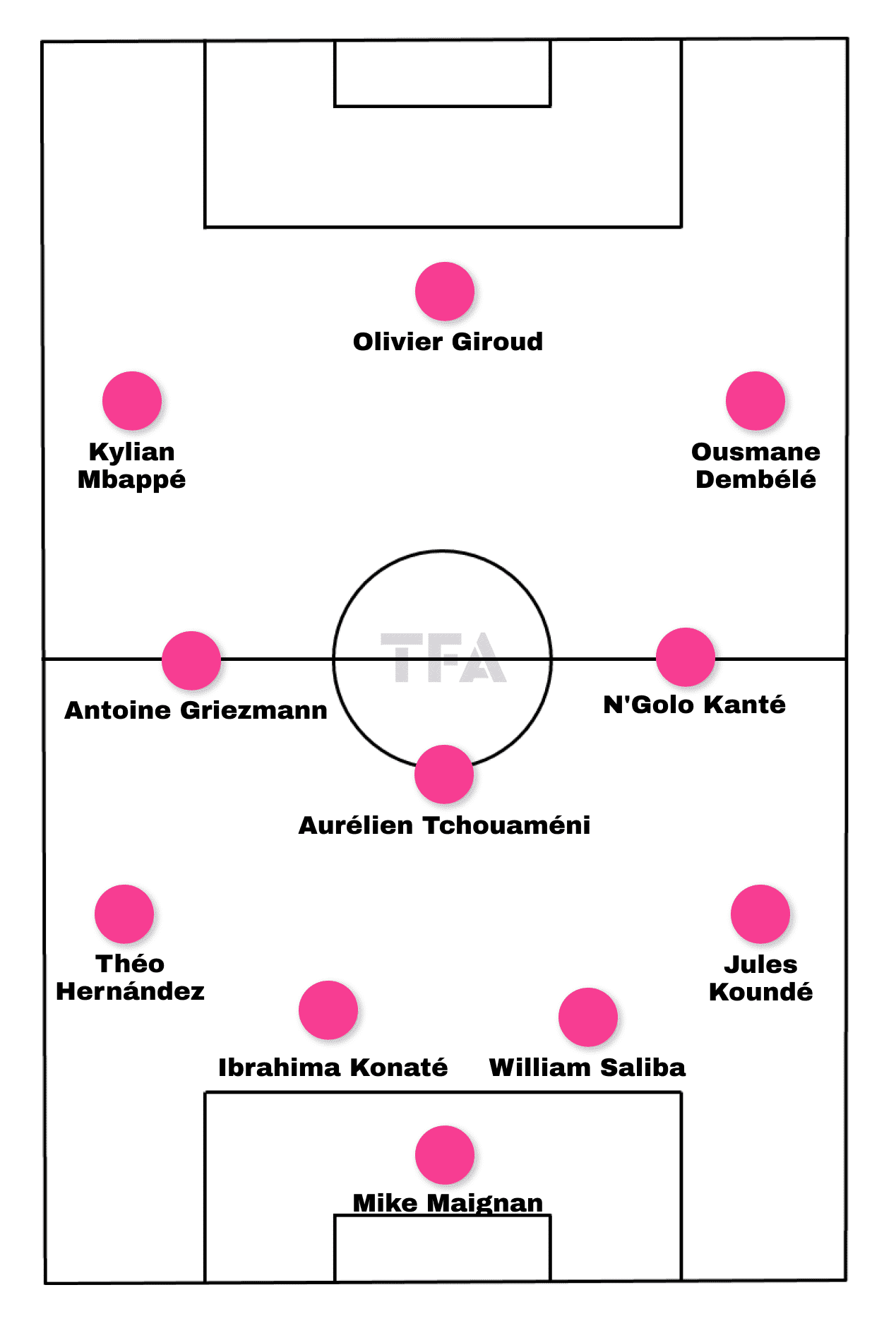
Firstly, we foresee Deschamps setting his side up in a 4-3-3/4-1-4-1 shape, as outlined in figure 1 above.
As of the writing of this article, the French squad for EURO 2024 has just been officially announced.
The big news from the squad announcement is N’Golo Kanté’s return to the side for the first time since 2022.
Kanté is a unique asset who’s unlikely to be included just to make up the numbers; we expect him to have a part to play in the tournament; hence, we’ve included him in our predicted ideal starting XI above, just in front of Aurélien Tchouaméni and to the right of Antoine Griezmann in a midfield trio that’s sure to evoke concern in even the strongest opposition at this summer’s Euros.
Should he remain fit, Mike Maignan is likely to start between the sticks behind a back-four consisting of right-back Jules Koundé, right centre-back William Saliba, left centre-back Ibrahima Konaté and left-back Théo Hernández.
Up front, we’ve gone for a three-man forward line featuring star man Kylian Mbappé, who’s set to leave Ligue 1 giants PSG this summer, opposite his soon-to-be ex-club teammate for Les Parisiens Ousmane Dembélé on the right with Olivier Giroud, in what could be his international swansong, starting in the number nine position.
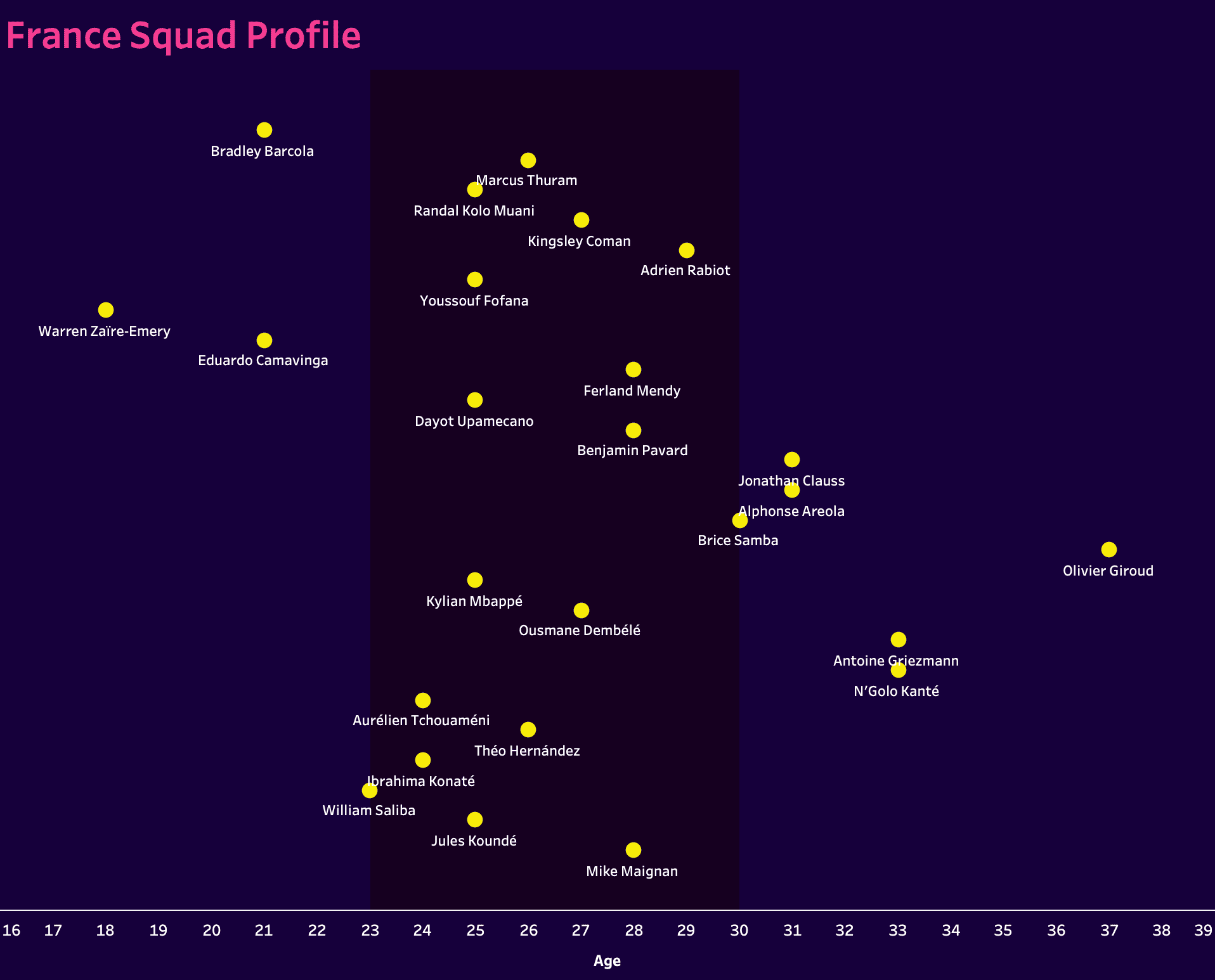
The vast majority of France’s 25-man squad (17) fall within the peak age range, with three coming under the ‘youth player’ banner and five situated in the ‘experienced’ category — a fairly healthy mix.
Attacking phase
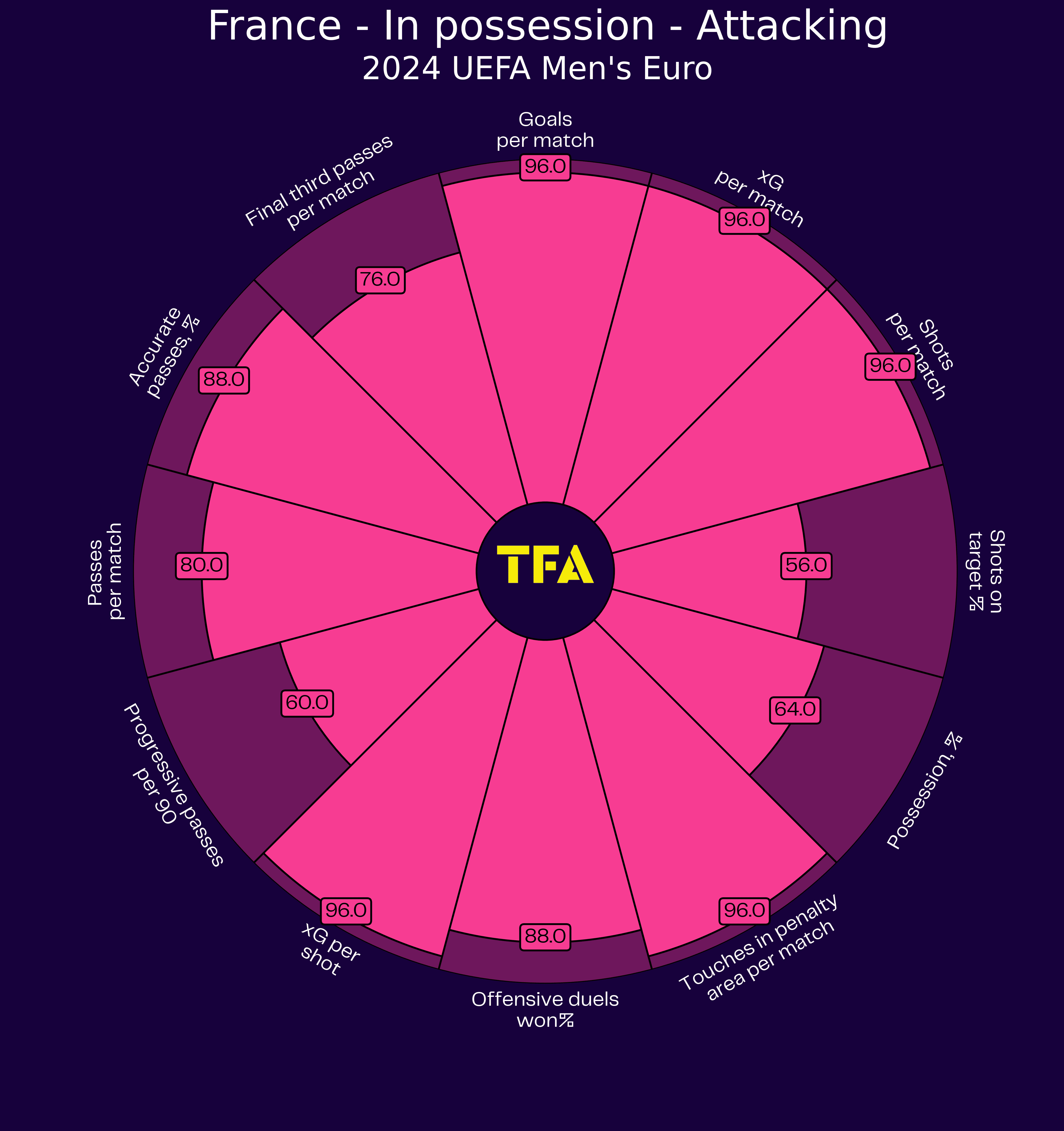
As figure 3 indicates, and as you might’ve surmised from your own knowledge of the quality within this squad and where their strengths lie, France enter the Euros as one of the strongest sides when it comes to their possession play.
Using data taken from all games played within the last calendar year, France rank pretty highly within almost every offensive category when compared to their EURO 2024 foes.
However, shots on target notably leaves a lot to be desired.
Still, they’ve managed to generate an extremely high number of shots and goals per match, so when they hit the target, they tend to be clinical and produce nigh-on unstoppable efforts.
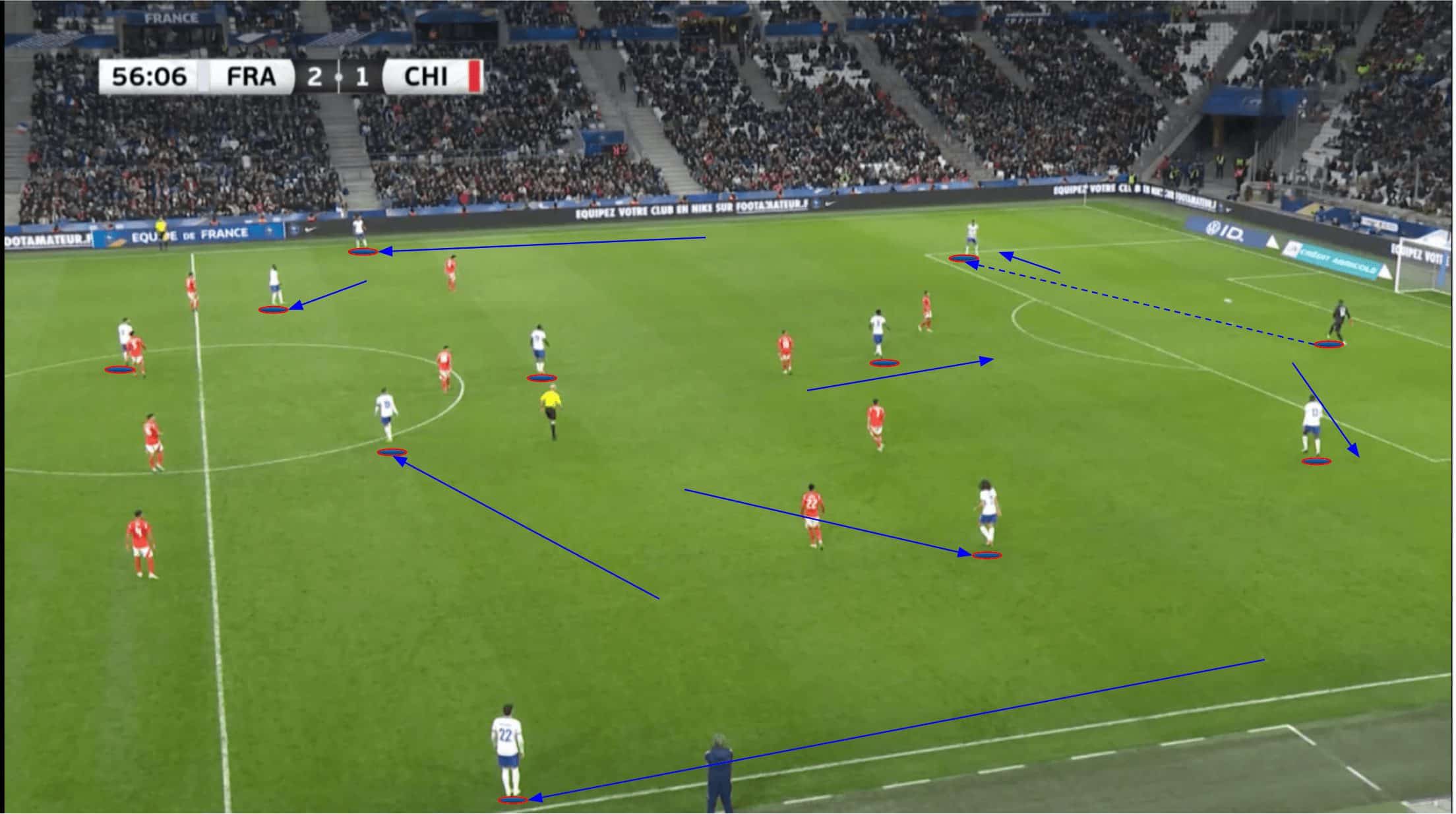
Figure 4 shows how France shaped up in the build-up phase, particularly during the second half of their recent international friendly against Chile.
In the earlier stages of the game, their full-backs sat deeper and, in the case of right-back Koundé, narrower than we see them here.
Over the course of the 90 minutes, the full-backs’ base positions became higher, thus resulting in the wingers inverting more.
To make up for the full-backs’ high positioning, France’s midfielders began dropping deeper, with Mattéo Guendouzi almost taking up the kind of position you might’ve expected to see left-back Hernández occupying at times earlier in the game, indicative of how Deschamps’ approach to build-up evolved over this particular clash with Chile.
Perhaps this was partly done to allow the wingers, especially Mbappé, the freedom to come inside without sacrificing width — perhaps it was just done to generate more rotations in deep areas designed to create more freedom and space for those looking to receive in France’s second line just in front of the centre-backs.
However, in any case, this definitely saw France build up more successfully and highlights the tactical versatility and adaptability that exists within this side under Deschamps, something that’ll be pivotal if they’re to progress deep into the Euros this summer and react to different opponents.
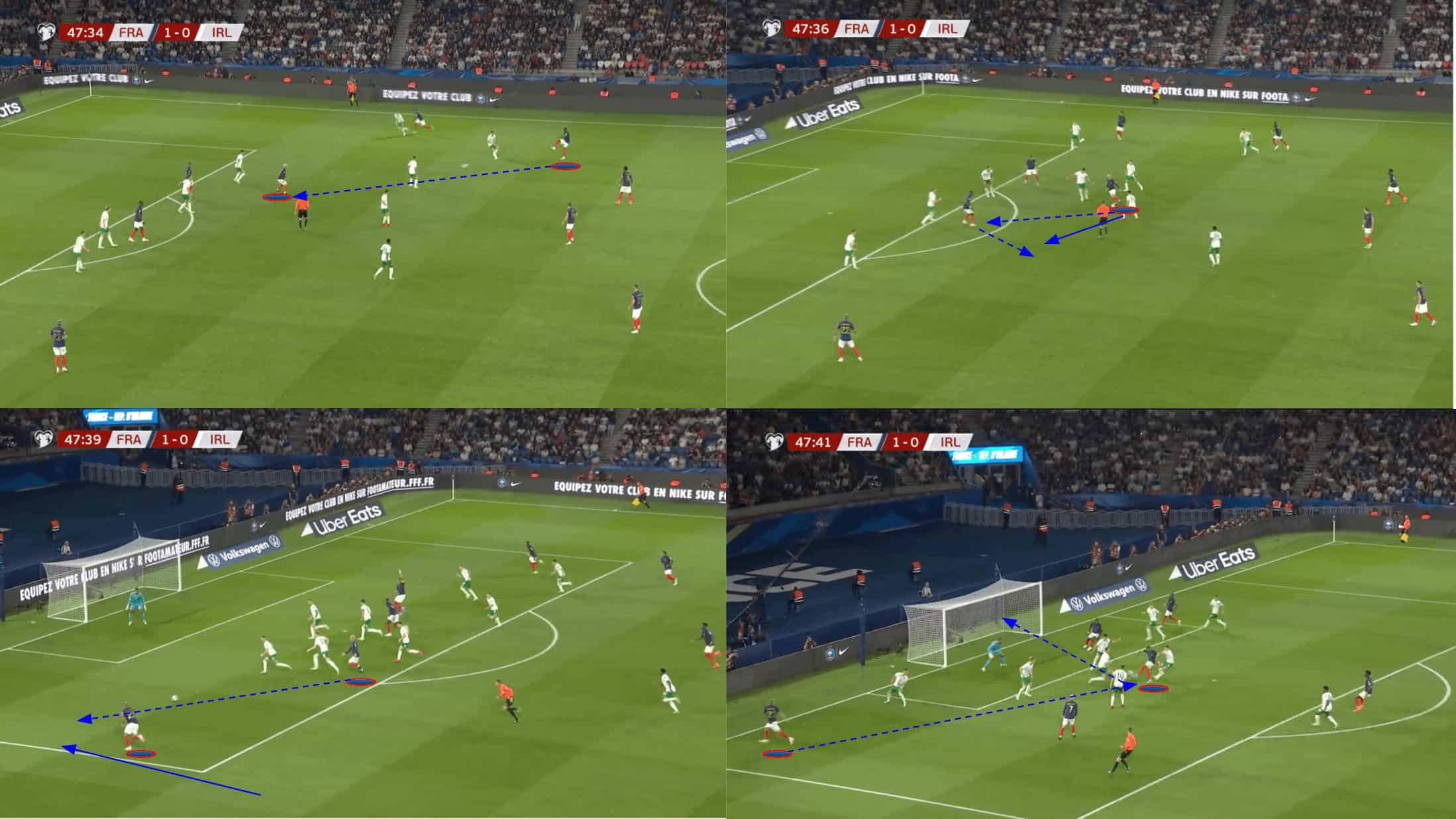
As mentioned above, Mbappé is likely to invert during possession phases rather than stay wide as a traditional winger might.
The annual Ballon d’Or contender is given plenty of freedom to pick up spaces he sees beneficial for him and, simultaneously, the team as a whole.
This means others need to react and provide balance on the left in his absence, which we see Hernández doing wonderfully in the example above.
After Mbappé came narrow, Hernández provided width via an overlapping run, which Griezmann took advantage of with the through ball he executed on the edge of the penalty area.
In the end, this move provides a perfect example of how France’s attack can become incredibly harmonious inside the final third, as Hernández’s low-driven pullback cross meets Mbappé who’s found just enough space to get a lethal shot off around the penalty spot, converting the ball into the net.
Mbappé’s movement was pivotal here in all senses — both in terms of how he came narrow from his wider left-wing position and then lost all markers in the middle of the box to convert Hernández’s cross.
It’ll be important for France that the left-back constantly gets forward to support the attack on that side to provide options as Hernández did here.
Those in midfield will be looking out for their runs into space, which could be key to Les Bleus’ EURO success.
Defensive phase
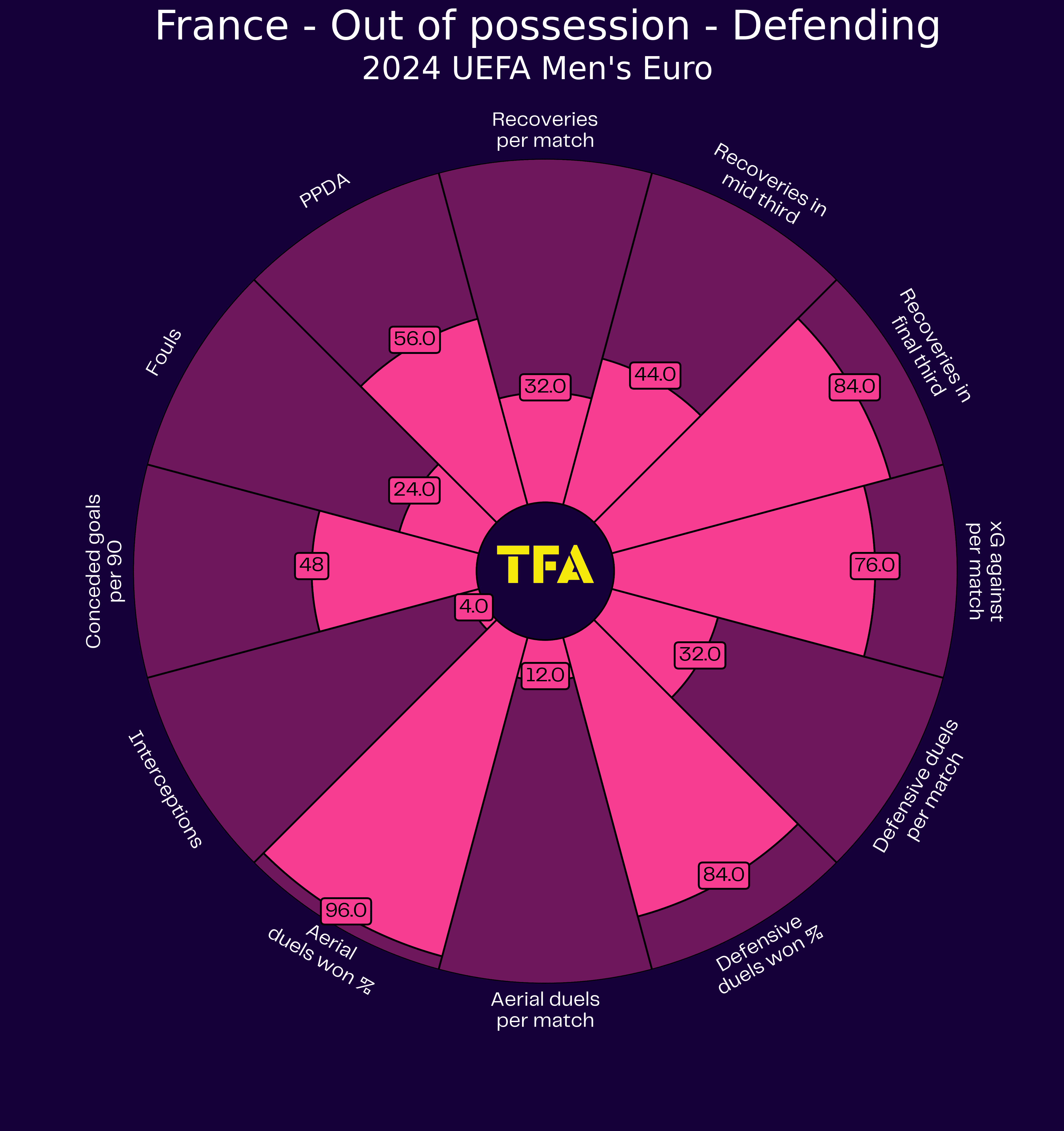
Using out-of-possession metrics taken from the same time frame as we used to analyse their attack to assess France’s defensive capabilities, Les Bleus have typically been very reliable at regaining the ball high and emerging victorious from their duels over the time period analysed, as much of a credit to their players’ individual quality in winning their 1v1 battles as much as a credit to Deschamps’ tactical setup.
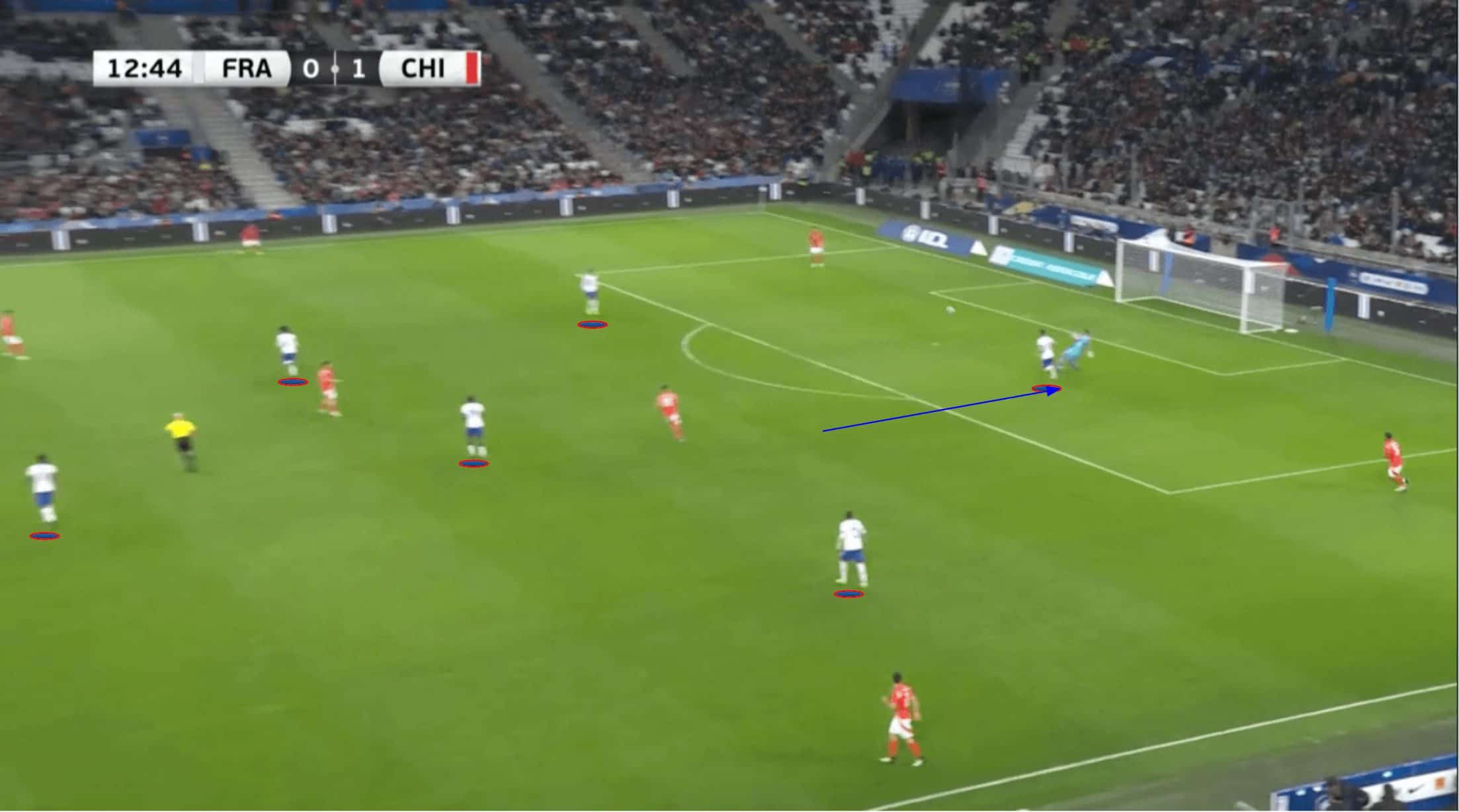
France defend in a 4-1-4-1 shape featuring a position-oriented press that sees defenders get tight to opponents who invade their designated area attempting to get onto the ball.
This sees midfielders, in particular, react aggressively as opponents drift across from one side of the pitch to another.
There’s not a great deal of pressing intensity in France’s forward line, and you can especially expect Mbappé to shirk some of his defensive duties with an eye on positioning himself advantageously in case an opportunity to counterattack presents itself.
However, France’s defensive organisation in the midfield and defensive lines is exceptional and warrants attention, as this has been the key to their high-quality high regains over the past calendar year.
In Figure 7, we see France’s press forcing the opposition to play a medium-length ball, with all short options reasonably well marked out of the game.
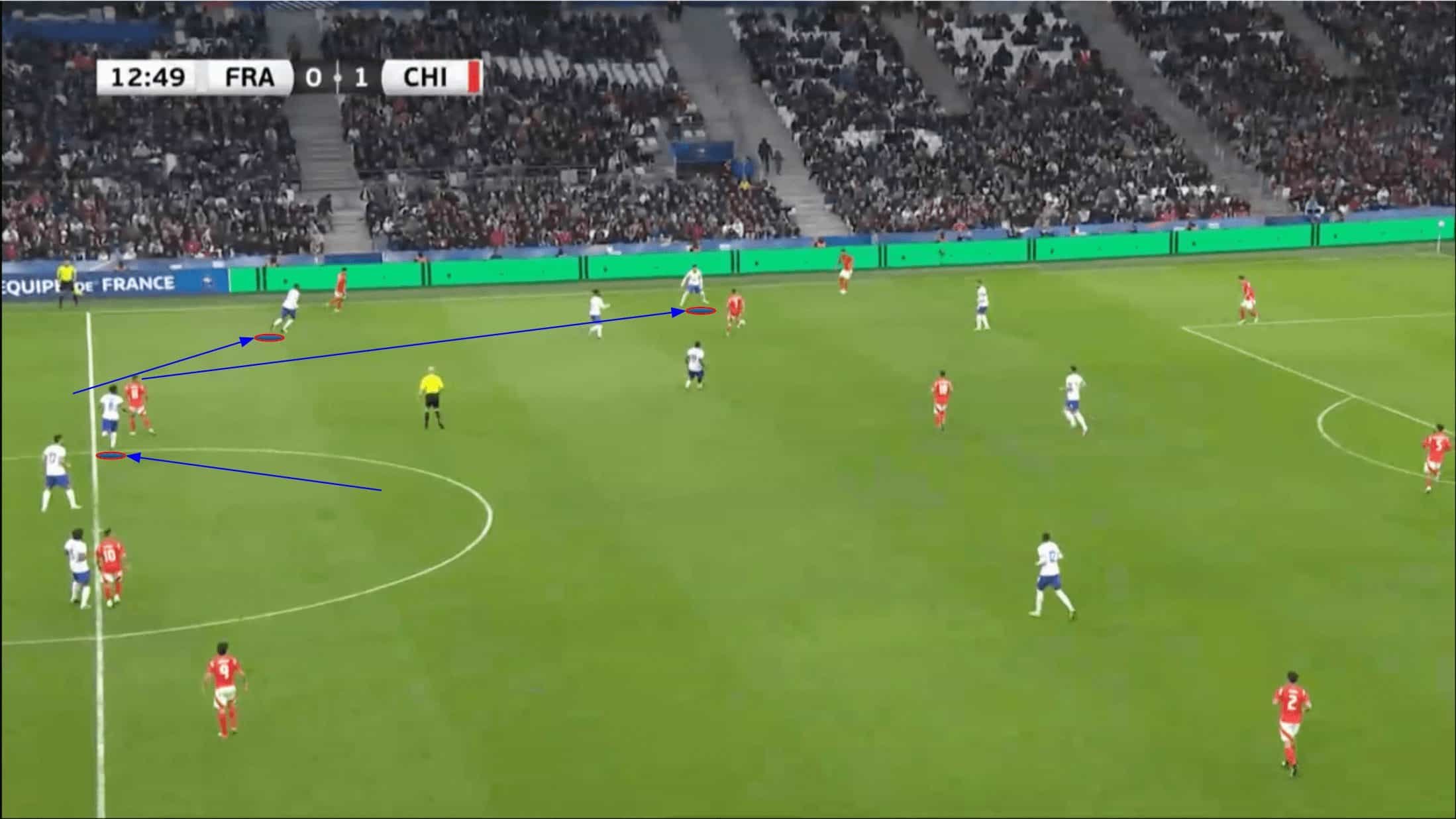
As the ball moves out to Chile’s right wing, France’s left-back, Hernández, is already well on his way up the pitch to close the receiver down.
While this could open up space behind him for other players to exploit, potentially leaving Deschamps’ side vulnerable, the left centre-back has shifted over seamlessly to provide cover out wide.
At the same time, the holding midfielder has slotted into the central defensive position on that side of the pitch, keeping holes in France’s defence plugged.
This does vacate parts of the midfield, but there’s not really much threat there at this moment, indicating how France’s deeper players have organised themselves really well to respond to the threat at this very moment, something that is quite common in their game.
Transitions
Our next section of analysis focuses on transitions, another area of the game in which Deschamps’ side typically excels.
Firstly, when it comes to their transitional attacks, we can expect to see Les Bleus threatening regularly when given the opportunity, in no small part thanks to the electric pace they boast on the wings, with Mbappé almost sure to start on the left and the possibility of either Ousmane Dembélé or Kingsley Coman featuring on the right.
All of those wide attackers mentioned harbour highly intelligent positioning as their side defends and place themselves well to capitalise on any incoming counterattacking opportunity.
At the same time, they also have exceptional pace and a great end product, making France’s counterattacks something that could inspire fear in any opponent.
While opposition backlines will be wary of giving France much space to target in behind, they’ll still have to press those in deeper positions like Saliba, Konaté and Tchouaméni, who have the potential to carve the opponent’s defence open and put an opportunity on a plate for the attackers who’ll be chomping at the bit to get played into space behind, so with a player such as Mbappé unlikely to offer much in terms of defensive work rate, France will be looking to use the transitional threat he brings to the table as a deterrent for the opposition to commit one extra body forward — and punish them if they fail to head the warning.
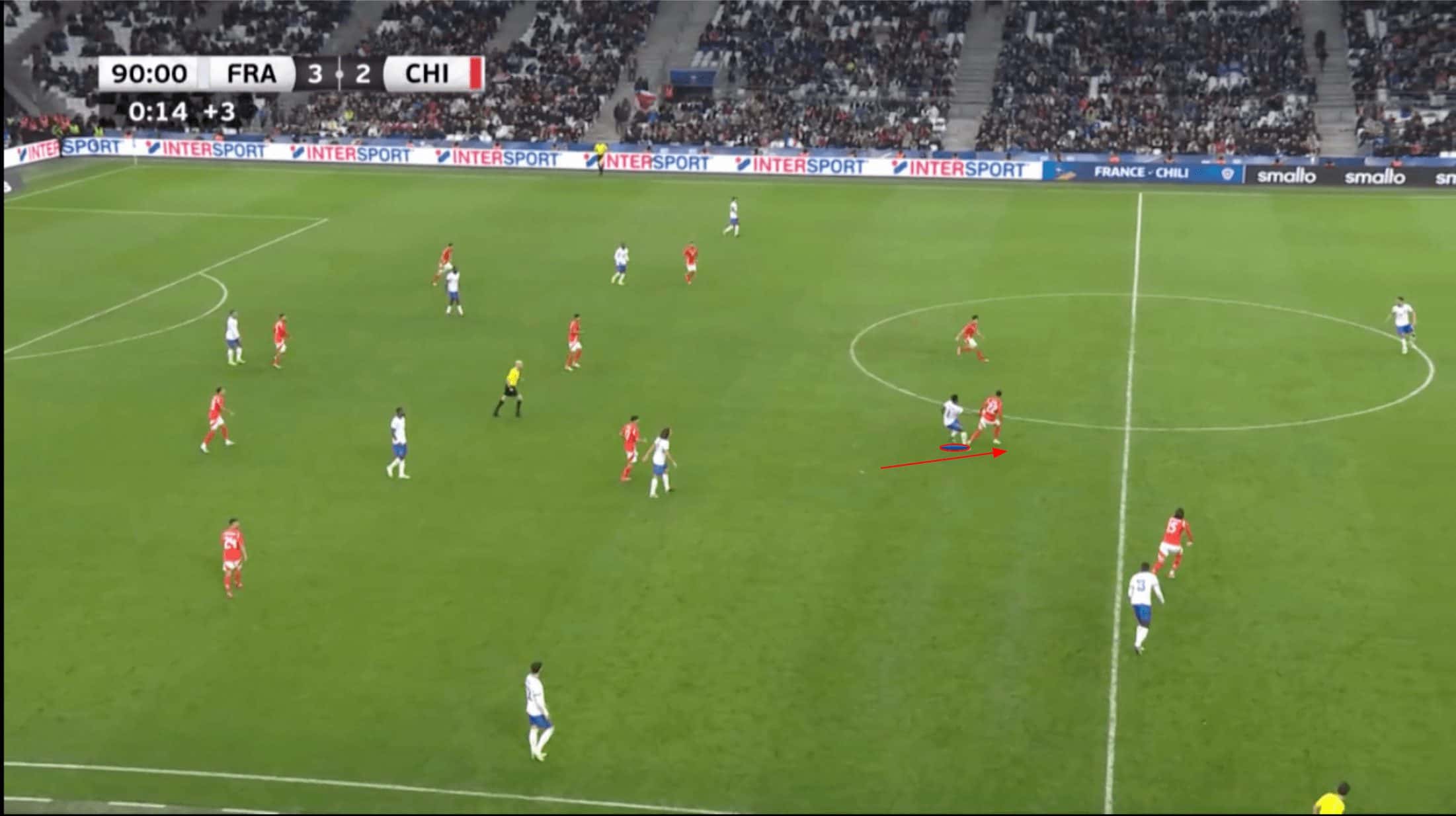
If put under pressure in those deep central areas, a player like Tchouaméni is not infallible and can be dispossessed, thus generating a decent counterattacking opportunity for the opposition, as we see in figure 9.
These are the kinds of mistakes France’s opponents will have to be brave enough to commit themselves to forcing in this competition.

This particular passage of play also provides us with a great example of the recovery pace that exists within Les Bleus’ backline.
Arsenal star William Saliba comes across from the right to provide just enough cover to slow down the Chilean counter here in figure 10, while his central defensive partner Konaté of Liverpool chases back to offer support.
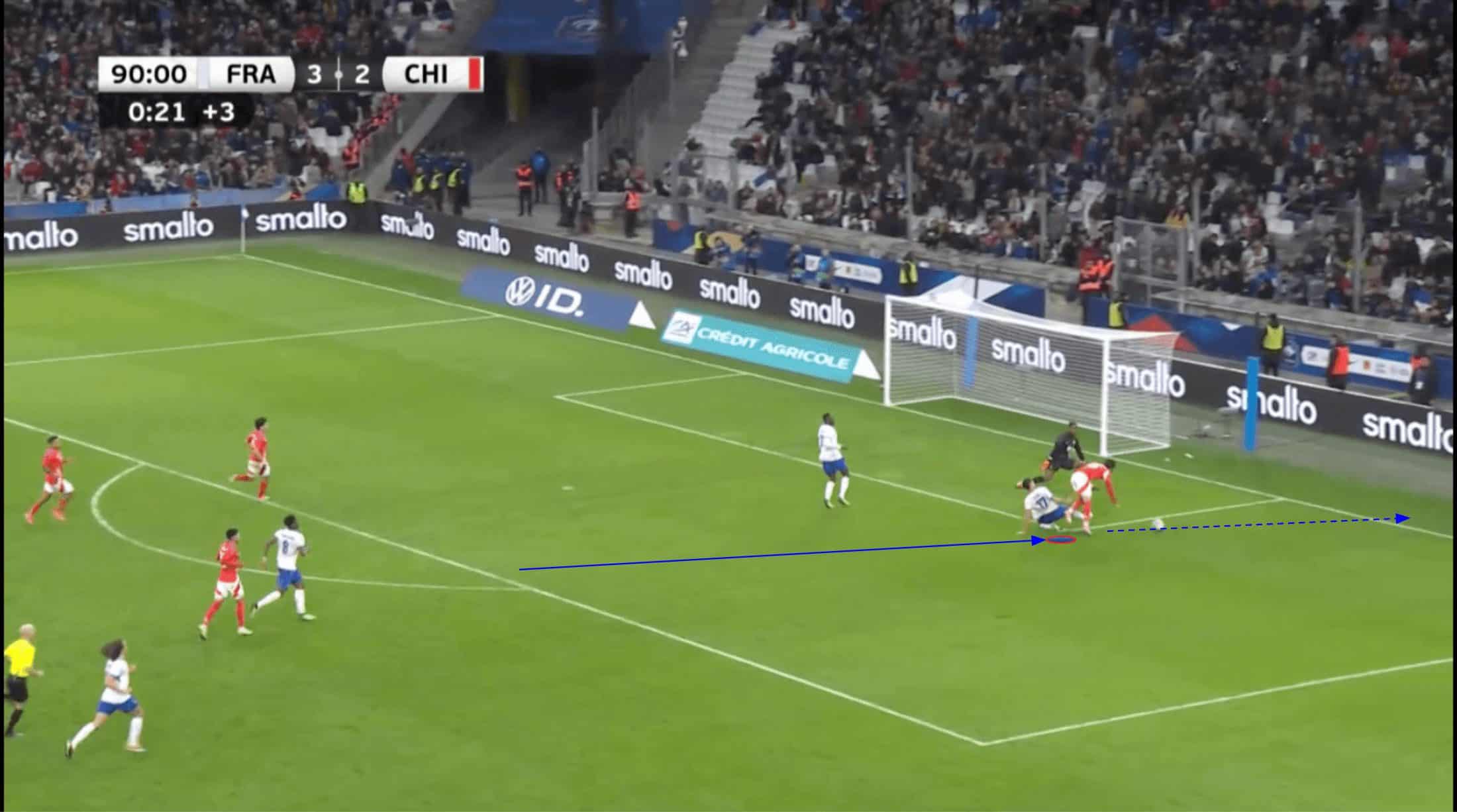
Saliba positions himself excellently to deny the dribbler a chance to get in on goal and force the attacker wide.
Eventually, the Arsenal man sees the ball carrier take a heavy enough touch that the window opens for him to get a foot in and knock the ball away, denying Chile the chance to even get a shot off from this once-promising transitional attack.
So, while France can be vulnerable if put under pressure in the ball progression phase, they also have a great deal of recovery pace and defensive nous to survive even the most threatening transitions.
Forwards
Mbappé is guaranteed a place in the starting XI when it counts, but we’d expect to see a fair amount of rotation all around France’s front three throughout this tournament; while we’ve got Olivier Giroud in the centre-forward position above, Randal Kolo-Muani and Marcus Thuram also represent decent options there as well as on the right wing, where Mbappé and Dembélé’s club teammate Bradley Barcola as well as Kingsley Coman could also feature.
Should Deschamps opt to take Mbappé out at times, Coman, Barcola, and Dembélé may also switch to the left for periods.
Again, you’re obviously going to see Mbappé used there when Deschamps believes it’s essential to have the strongest XI on the pitch unless he moves centrally as he did at times during the 2023/24 club campaign with PSG and has done for France previously—another aspect of France’s attack to keep a close eye on.
So, France’s attack, overall, is flexible both in terms of personnel and the roles each player can occupy, giving Les Bleus plenty of options going forward.
Midfielders
While we’ve put Kanté in our starting XI alongside Tchouaméni and Griezmann, there’s a case to be made for Adrien Rabiot to keep his place in the squad as part of a midfield trio that has become somewhat familiar with each other of late.
Furthermore, Youssouf Fofana of AS Monaco is coming off the back of what has been potentially a career-best season, so could well carry that momentum into the Euros and challenge for a place in Deschamps’ starting midfield trident as well.
Two of France’s three ‘youth’ players primarily feature in the midfield, with the versatile Eduardo Camavinga of Real Madrid joined by Warren Zaïre-Emery of PSG in the Euros squad.
Both players are likely to form a vital part of the French national team, so some strategic game time and tournament experience will be highly valuable for them this summer — expect to see them feature and hold their own as they also enter this tournament after producing a solid season with their respective clubs.
Defenders
As stated earlier, France boast an incredible amount of squad depth, which is evident in all areas of their squad, defence included.
Koundé, Saliba, Konaté, and Hernández are a back four that has featured for Deschamps in recent times.
We feel they offer a decent level of balance in the starting XI to keep Les Bleus well-stocked for all phases of play.
However, they also have Marseille’s Jonathan Clauss — arguably the best-attacking right-back in France’s top-flight this term — to choose from, along with Ferland Mendy, who can offer a lot going forward on the left side of the back four if they fancy something different to Hernández.
Meanwhile, Benjamin Pavard offers versatility and gives Deschamps a top-quality option for tactical diversity throughout the tournament, and Dayot Upamecano completes the defensive options as a solid bit of central defensive competition.
Key Player
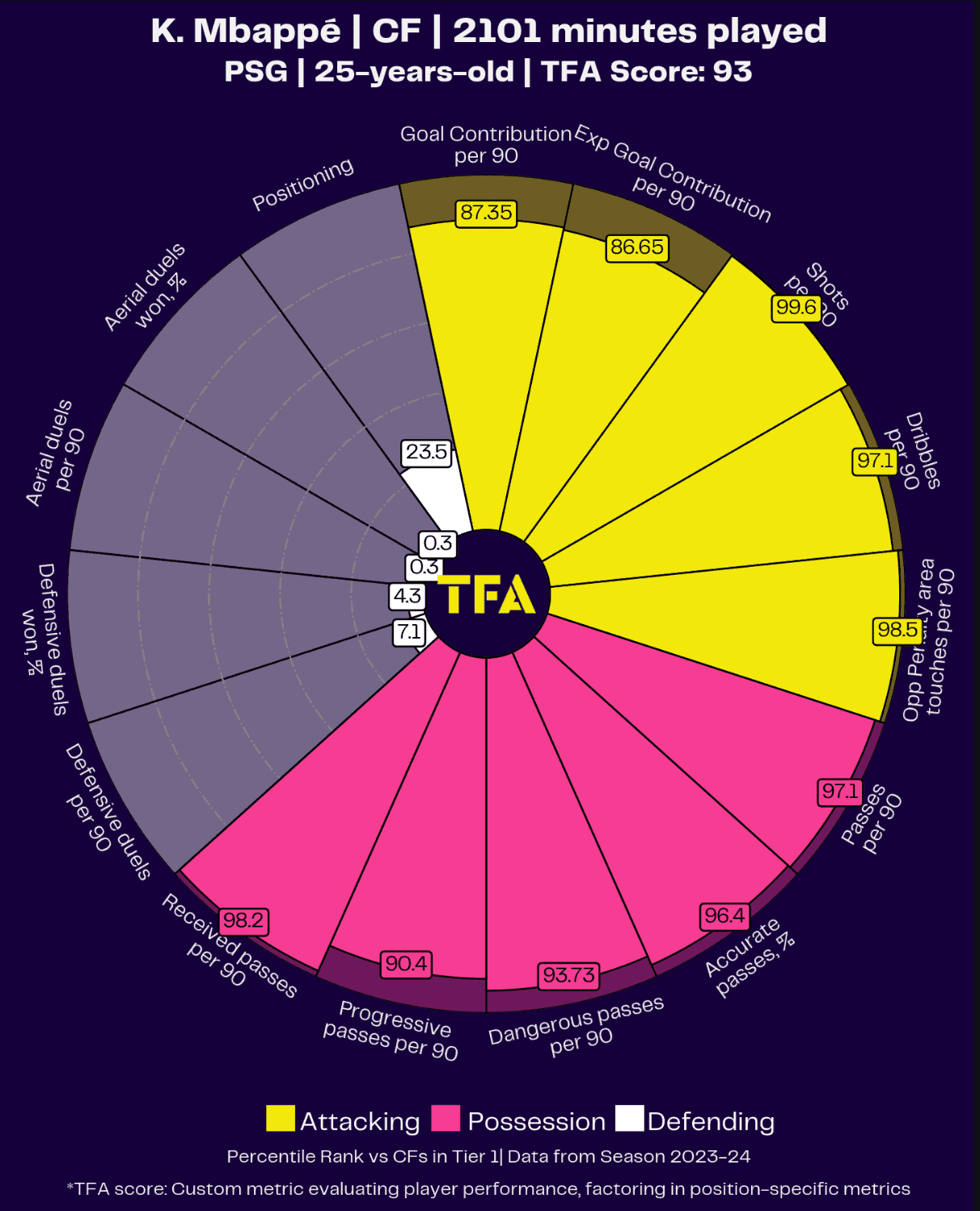
The ‘Forwards’ section provides a nice segue into our ‘Key Player’ section, where — once more — we can bang on about Kylian Mbappé’s excellence.
The soon-to-be ex-PSG star has been the focal point of his national team for years now and will undoubtedly be the key man for opponents to focus on — and, indeed, for his teammates to try and get into the best possible situations as much as they can — throughout this summer’s Euros.
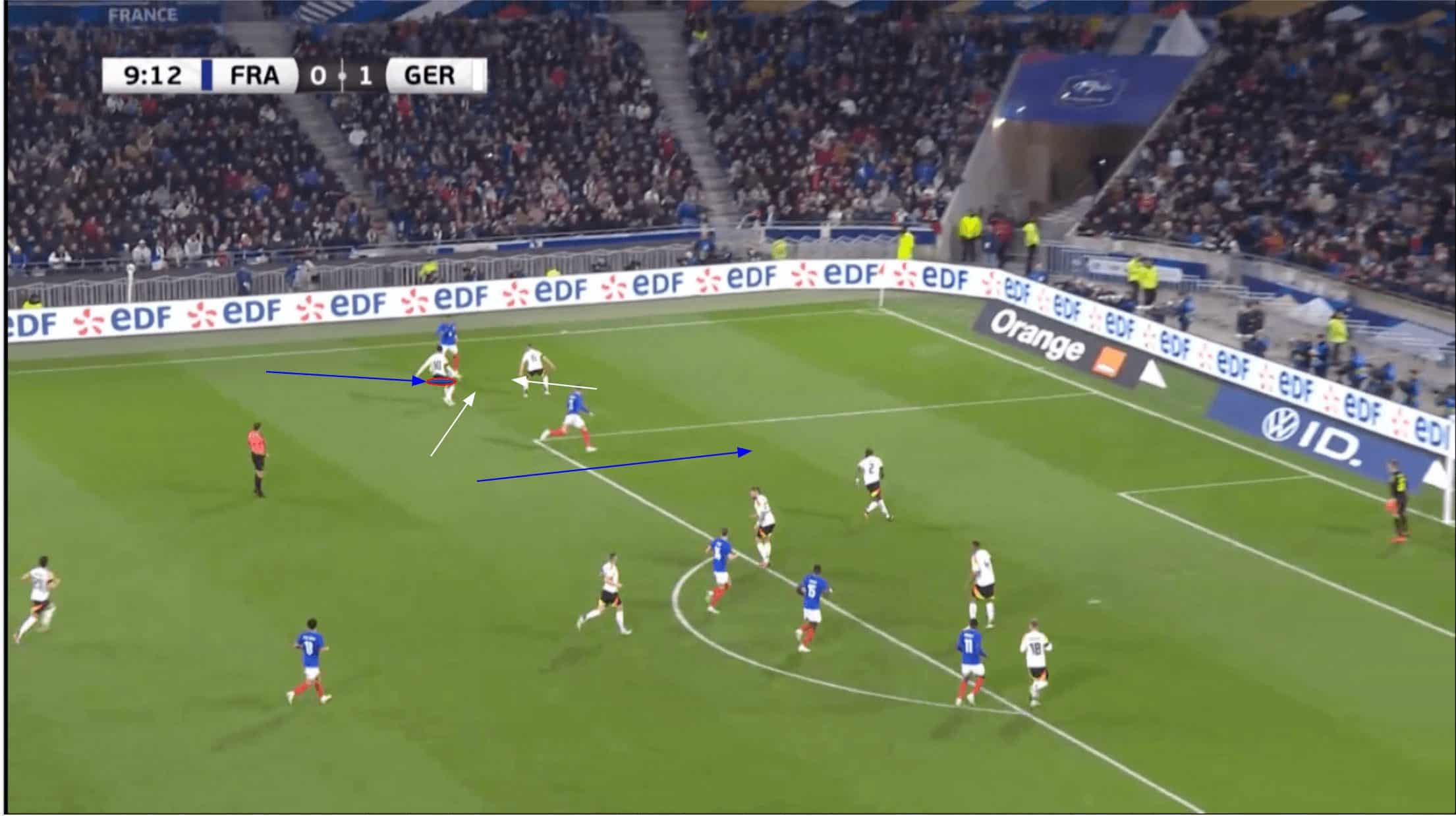
Mbappé is well able to draw defenders in during attacks, with Germany effectively doubling up on the attacker here.
It was to no avail, as Mbappé exploited the small gap between the two defenders to find his teammate attacking the space behind them with his run, highlighting how even when at a numerical disadvantage, the 2018 FIFA World Cup winner has enough quality to keep his side moving into even more valuable positions.
As the pizza chart above shows, Mbappé will offer his team very little in defensive phases—that’s the nature of his game.
However, the trade-off is the unequivocal quality he brings on the ball, as we can observe above, and the major threat he offers on the counter.
Should France succeed in getting the most out of the 25-year-old wide forward this summer, expect them to at least get very close to reaching their full potential, which is a scary thought for all other Euro hopefuls.
Tournament prediction
To conclude our piece, we see France topping Group D, which is perhaps the most competitive of the six groups on paper, barring any major upsets, which could absolutely happen, as we saw when Les Bleus crashed out to Switzerland in the Round of 16 in the previous edition of this competition.
After that, anything can happen in knockout football, but France are one of the biggest favourites entering this tournament for a reason and will have their sights set on lifting the trophy.
The return of N’Golo Kanté to the squad will surely offer a huge boost both on and off the pitch as well and inspire confidence in the team, so it’s certainly worth keeping a close eye on Les Bleus; they have the player quality and tournament experience to do very well in EURO 2024.

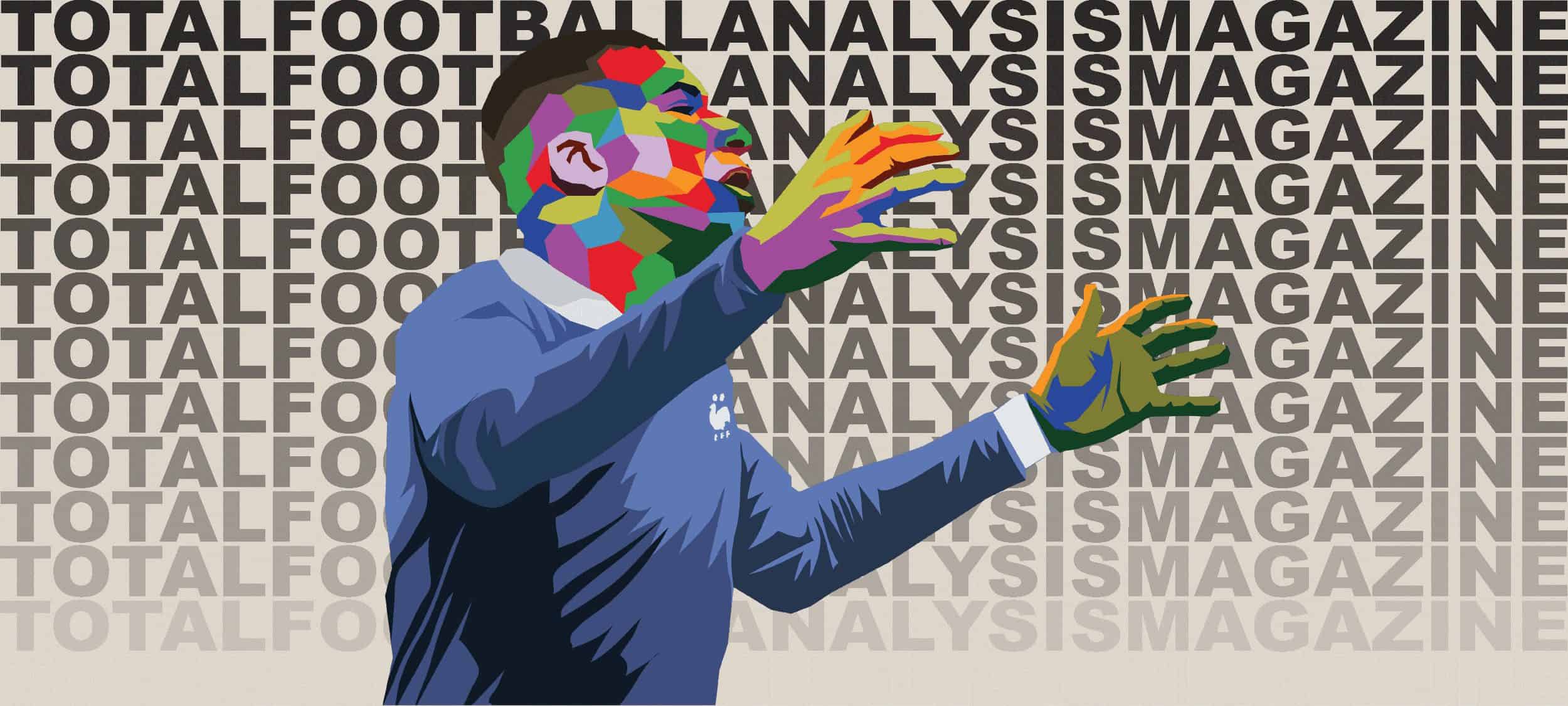



Comments